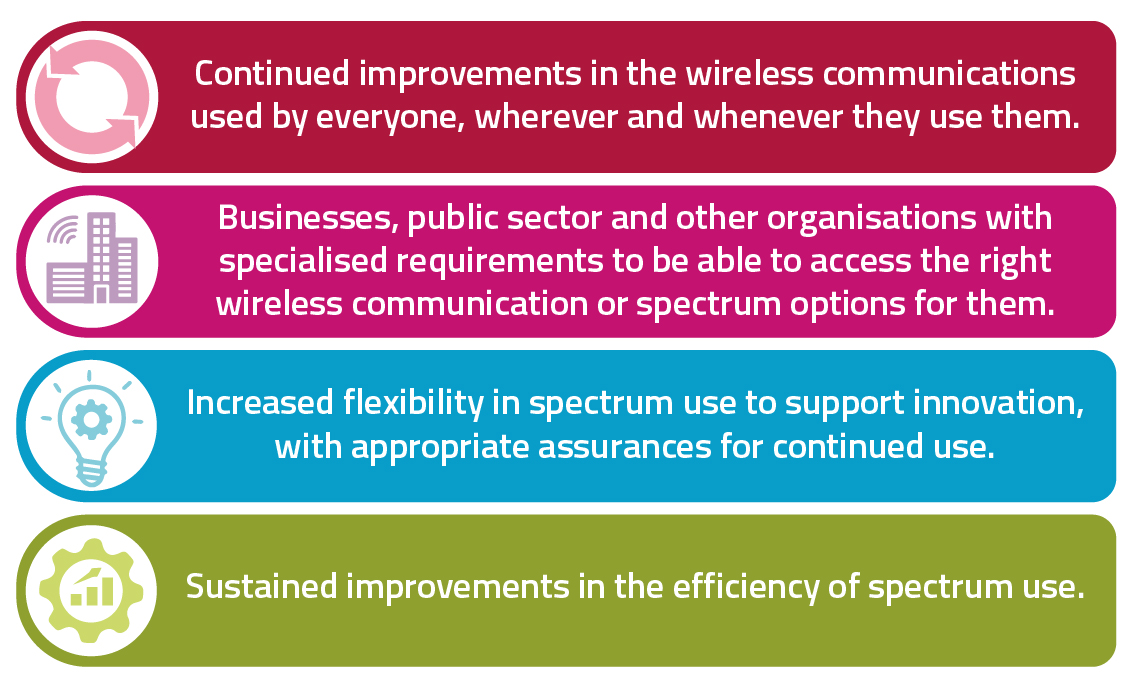Spectrum management
Ofcom has the job of making sure that the radio spectrum is used in the best interests of everyone in the UK.
In our spectrum management strategy for the 2020s, we set out our vision for the UK's wireless future. Innovation and continuous improvement are at the heart of this vision, which has four main objectives:

In this section, you'll find more information about our current work.
Featured content
Wireless broadband traffic has grown significantly over the last decade, and we expect this to continue. The upper 6 GHz band (6425-7070 MHz) has generated interest from industry to support this ongoing traffic growth, either by licensed mobile use or low power Wi-Fi under licence-exemption. The next World Radiocommunications Conference (WRC) in 2023 will discuss any future identification of the band.
We see potential benefits for consumer benefit from either higher-power licensed mobile or from lower-power Wi-Fi of the upper 6 GHz band, but the case between the two is currently finely balanced.
In February 2022, we proposed to add the band (PDF, 1.4 MB) to Ofcom’s Shared Access licensing framework for low-power, indoor use, as an interim step to enable access to the band while further work to establish its long-term future is being done. In light of consultation responses, lack of evidence of demand and the wider discussions surrounding the upper 6 GHz band, we decided not to proceed (PDF, 138.7 KB) with our proposals to add the band to the Shared Access licensing framework.
In December 2022, we published an update on our position on access to the upper 6 GHz band for mobile services. The update document explains why we currently favour a "no change" outcome to the discussions at WRC-23. This will not preclude us from making the band available for licenced mobile use in the future. At a later date, we will consult on proposals for future use of the band in the UK.
There are a number of spectrum bands which can now support 5G services in the UK:
- In 2018 we awarded licences by auction in the 2.3 GHz and 3.4 – 3.6 GHz bands.
- In 2021, we awarded more spectrum in the 700 MHz and 3.6 – 3.8 GHz bands.
Following these awards, mobile network operators (MNOs) asked Ofcom to review their earlier licences and revise them in line with CEPT and EU decisions on harmonised technical provisions, to facilitate the deployment of 5G. In May 2022, we consulted on specific variation requests made to us, and in September 2022 we published our decision (PDF, 210.8 KB) to grant the variations and update licences in the 900 MHz, 1800 MHz, 2100 MHz and 2.6 GHz bands.
All mobile licensees have now received the variations to their licences, meaning that they can deploy 5G in these bands at any time, without requiring further regulatory consent or intervention. Copies of MNOs' licences and their frequencies are available on our website.
On 9 May 2022, we published a consultation (PDF, 4.5 MB) proposing to make millimetre wave (mmWave) spectrum available in the 26 GHz and 40 GHz bands for use of mobile technology, including 5G.
On 13 March 2023, we published a statement (PDF, 3.6 MB) on our approach to existing users of this spectrum, and the authorisation of the 26 GHz band. We are also consulting on our proposals for the design of the auction for citywide licences, the licence conditions for citywide and local mmWave licences and how we will coordinate users of this spectrum.
In 2019, we launched a new framework for enabling shared use of spectrum, aiming to make it easier for people and businesses to access spectrum for a wide range of local wireless connectivity applications:
- Shared access licences are available in four frequency bands (1800 MHz, 2300 MHz, 3800-4200 MHz and 24.25 – 26.5 GHz), which support mobile technologies including 5G, and can be used for both private and business use.
- Local access (PDF, 232.5 KB) licences may provide short-term access to spectrum that is licensed to mobile operators. This is subject to availability, such as in areas where mobile operators have not yet deployed services in the relevant spectrum.
On 1 February 2019, we published a discussion paper on how wireless technology can help business to innovate and be more efficient.
From time to time, Ofcom carries out work to clear existing authorised users so that spectrum is available for new uses (clearance). We might also work with existing users to consider how they can co-exist with new uses by managing any potential interference (co-existence).
Information about our previous clearance and co-existence work relating to the 700 MHz and 800 MHz bands is available at the National Archives.
Information about older projects is available via the National Archives.
